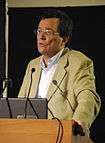Tuscan regional election, 2000
| | ||||||||||||||||||||||||||||||||||||||||||||
| ||||||||||||||||||||||||||||||||||||||||||||
| ||||||||||||||||||||||||||||||||||||||||||||
| ||||||||||||||||||||||||||||||||||||||||||||
The Tuscan regional election of 2000 took place on 16 April 2000.
Electoral law
Tuscany used the national Tatarella Law to elect its Council. Forty councillors are elected in provincial constituencies by proportional representation using the largest remainder method with a Droop quota and open lists; remaining seats and votes are grouped at regional level where a Hare quota is used, and then distributed to provincial party lists.
Ten councillors are elected at-large using a general ticket: parties are grouped in alliances, and the alliance which receives a plurality of votes elects all its candidates, its leader becoming the President of Lombardy. If an alliance wins more than 60% of votes, only five candidates from the regional list will be chosen and the number of those elected in provincial constituencies will be 45; if the winning alliance receives less than 50% of votes, special seats are added to the Council to ensure a large majority for the President's coalition.
Results
1999 European election marked a turning point in relations between Forza Italia and the Lega Nord. In fact, the assembly works in Parliament had highlighted a growing programmatic convergence between the two parties. And so, in view of the 2001 general election, Berlusconi and Umberto Bossi put aside the old, and even bloody quarrels, and formed a new coalition: the House of Freedoms, which found in the regional elections, also in Tuscany, its first test. So the center-right candidate, Altero Matteoli, an important figure on the national landscape, was sustained also by the Lega Nord, which in 1995 had sustained Chiti.
The combination of what were the major forces of regional politics, securing an appointment to Claudio Martini, which ensured stability of the Regional Cabinet that the new regulations wanted to coincide in term with the legislature. Democrats of the Left was confirmed as the largest party in the region with 36% of the vote, while Forza Italia was the second largest party with 20%. The Olive Tree, an alliance comprising several centre-left parties including the Italian People's Party, the Democrats of the Left, The Democrats, the Federation of the Greens and Party of Italian Communists, had a reconfirmation but lost votes.
Like 1995 election, Communist Refoundation Party run lonely with its candidate.
| Candidates | Regional lists | Provincial lists | Total | |||||||
|---|---|---|---|---|---|---|---|---|---|---|
| votes | % | seats | Parties | votes | % | swing | seats | party | group | |
| Claudio Martini | 1,029,142 | 49.30 | 10 | Democrats of the Left | 708,750 | 36.20 | -4.7 | 17 | 22 | 32 |
| Italian People's Party | 71,195 | 3.64 | -2.8 | 1 | 1 | |||||
| The Democrats | 64,606 | 3.30 | new | 1 | 1 | |||||
| Party of Italian Communists | 59,258 | 3.03 | new | 1 | 1 | |||||
| Federation of the Greens | 42,269 | 2.16 | -0.5 | 1 | 1 | |||||
| Italian Republican Party-Italian Democratic Socialists | 36,413 | 1.86 | new | - | - | |||||
| Union of Democrats for Europe | 2,406 | 0.12 | new | - | - | |||||
| Altero Matteoli | 836,001 | 40.05 | 1 | Forza Italia | 395,946 | 20.22 | +1.1 | 8 | 8 | 16 |
| National Alliance | 291,200 | 14.87 | +1.2 | 5 | 5 | |||||
| United Christian Democrats | 40,692 | 2.08 | new | 1 | 1 | |||||
| Christian Democratic Centre | 40,476 | 2.07 | -0.4 | 1 | 1 | |||||
| Socialist Party | 11,956 | 0.61 | new | - | - | |||||
| Lega Nord Toscana | 11,256 | 0.57 | 0.1 | - | - | |||||
| Tuscan Autonomist Movement | 2,176 | 0.11 | new | - | - | |||||
| The Liberals-Sgarbi | 853 | 0.04 | new | - | - | |||||
| Niccolò Pecorini | 159,862 | 7.66 | - | Communist Refoundation Party | 131,471 | 6.71 | -4.4 | 2 | 2 | 2 |
| Gianfranco Dell'Alba | 49,358 | 2.36 | - | Bonino List | 40,496 | 2.07 | +0.8 | - | - | |
| Paolo Vecchi | 12,950 | 0.62 | - | Humanist Party | 6,722 | 0.34 | new | - | - | |
| Total candidates | 2,087,313 | 100.00 | 11 | Total parties | 1,958,141 | 100.00 | = | 39 | 50 | 50 |
Source: Ministry of the Interior

